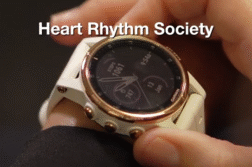CHICAGO, Ill. (Ivanhoe Newswire) – This year, more than 356,000 people in the U.S. will experience a cardiac arrest – their heart will just stop. It’s caused by arrhythmias that prevent the heart from pumping blood. Nearly 90 percent of them are fatal. Thousands of people will have a pacemaker or a defibrillator implanted to shock their heart back into action, but both come with complications. Now, new technology may prove to be a life saver for people who suffer a cardiac arrest.
Eighty-four-year-old Joseph “Joe” Mulligan lives and breathes for the Fighting Irish! As a 1959 alum, Joe gives tours of the campus, sings in the choir, and of course, never misses a game. In fact, it was 10 years ago when something terrible happened.
“The weekend of the Notre Dame/Navy game, and I got up that morning and felt terrible,” Joe recalls.
That was the first sign of his first cardiac arrest. Five years later, it happened again.
“When the heart stops pumping blood, there’s no blood going to the brain. And within about five to 10 seconds, the patient will collapse,” explains Electrophysiologist at Northwestern Medicine’ Bluhm Cardiovascular Institute, Bradley Knight, MD.
Traditionally, Joe would be given an implantable cardioverter defibrillator, or ICD — it uses thin wires, or leads, that are placed directly into the heart to deliver electric currents if his heart stops again.
Dr. Knight further explains, “They’re electrical cables surrounded by insulation. And over time, these leads have the potential to break or to fail.”
But Dr. Knight instead used a first of its kind extravascular implantable cardioverter defibrillator, or EV ICD. The difference: it doesn’t place wires directly into the heart.
“A major advantage of that approach is that the lead is now under the bone, now on top of the bone. The energy it takes to shock the heart is significantly lower,” Dr. Knight says.
A worldwide clinical trial found the EV ICD was 98 percent effective. Ninety-two percent of patients experienced no major complications. The new ICD lasts up to 11 years, compared to eight years for the traditional one, using less electricity, with less risk of blockage of veins and blood infections.
“Most patients who receive an appropriate shock for a cardiac arrest is lifesaving. They would not have survived that event without an implantable defibrillator,” Dr. Knight adds.
Using cellular data or wi-fi, the EV ICD also tracks if the device is ever used. Last year, Joe didn’t even realize it, but his heart stopped again. The EV ICD shocked his heart back into motion and alerted his doctor.
“So far, it’s saved my life once,” Joe says with relief.
And now, Joe is looking forward to many more games – celebrating his team and his life.
The EV ICD is not yet FDA-approved. Medtronic has received approval for a continue access study and hope to make it available to all patients who need an implantable defibrillator within the next few months.
Contributors to this news report include: Marsha Lewis, Producer; Matt Goldschmit, Videographer; Roque Correa, Editor.
To receive a free weekly e-mail on medical breakthroughs from Ivanhoe, sign up at: http://www.ivanhoe.com/ftk
Source:
MEDICAL BREAKTHROUGHS
RESEARCH SUMMARY
TOPIC: FUTURE OF CARDIAC CARE: LIFESAVING TECH PREVENTS SUDDEN CARDIAC DEATH
REPORT: MB #5293
BACKGROUND: Cardiac arrests are a critical medical emergency characterized by the sudden loss of heart function, often resulting from an electrical malfunction in the heart that leads to an irregular heartbeat (arrhythmia). Without quick intervention, cardiac arrest can be fatal within minutes. The primary treatment for cardiac arrest involves cardiopulmonary resuscitation (CPR) to pump blood and provide oxygen to the body manually. Additionally, automated external defibrillators (AEDs) are crucial in resuscitating individuals. AEDs are portable electronic devices that can analyze the heart’s rhythm and, if necessary, deliver an electric shock to restore a normal heartbeat. Their automated prompts help even non-medical professionals to deliver life-saving care in critical situations. This combination of CPR and AED intervention significantly improves the chances of survival for individuals experiencing cardiac arrest.
(Sources: https://www.mayoclinic.org/diseases-conditions/sudden-cardiac-arrest/symptoms-causes/
https://www.osha.gov/aed#:~:text=An%20automated%20external%20defibrillator%20(AED,
DIAGNOSING: Diagnosis typically involves a combination of clinical signs, symptoms, and the absence of a palpable pulse. Patients in cardiac arrest often show loss of consciousness, absence of normal breathing, and lack of detectable pulse. Electrocardiography (ECG) plays a key role in confirming the diagnosis, providing real-time assessment of the heart’s electrical activity. ECG readings can reveal specific arrhythmias that indicate cardiac arrest, such as ventricular fibrillation or asystole. Additionally, blood tests like troponin may be administered to further support the diagnosis and assess the severity of myocardial damage. A swift and accurate diagnosis is essential in increasing the chances of survival.
https://www.webmd.com/heart-disease/what-is-cardiac-troponin-test)
NEW TECHNOLOGY: Physician-scientists at Cedars-Sinai’s Smidt Heart Institute have developed an artificial intelligence (AI) tool featured in JAMA Cardiology that distinctly discerns between two typically difficult-to-find and life-threatening heart conditions, hypertrophic cardiomyopathy and cardiac amyloidosis. These conditions pose diagnostic challenges even for seasoned cardiologists, leading to delayed diagnoses for patients spanning years or even decades. Dr. David Ouyang, a cardiologist at the Smidt Heart Institute and the study’s senior author, emphasized the AI algorithm’s ability to detect unnoticeable disease patterns, enabling precise diagnoses. The algorithm outperformed expert clinical eyes in identifying high-risk patients, as it catches subtle cues in ultrasound videos, distinguishing conditions that can initially appear similar. Ouyang envisions early implementation of this technology to identify patients at the onset of their disease. He recognizes that early intervention maximizes the benefits of available therapies, which is crucial in preventing severe outcomes like heart failure, hospitalization, and sudden death.
FOR MORE INFORMATION ON THIS REPORT, PLEASE CONTACT:
Megan McCann
If this story or any other Ivanhoe story has impacted your life or prompted you or someone you know to seek or change treatments, please let us know by contacting Marjorie Bekaert Thomas at mthomas@ivanhoe.com




